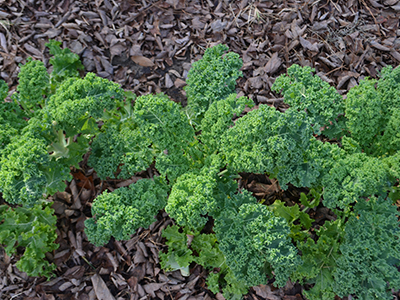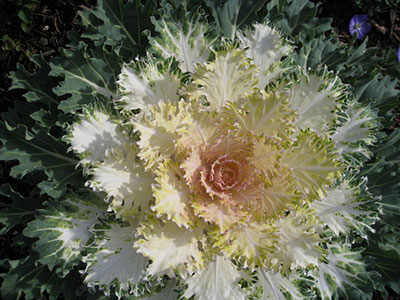Kale
 Kale is a dark-green leafy vegetable that can be grown during the winter months in Florida. It's often referred to as a "superfood" because it's rich in iron, calcium, and vitamins A, C, and K.
Kale is a dark-green leafy vegetable that can be grown during the winter months in Florida. It's often referred to as a "superfood" because it's rich in iron, calcium, and vitamins A, C, and K.
Characteristics
Kale has one of the sweetest flavors of all the leafy greens, making it a popular vegetable to grow. The leaves can be harvested as needed, providing you with a steady supply of healthy greens.
Kale adds a big nutritious boost to fruit smoothies. You can even bake the leaves to make crispy kale chips, turning them into a nutritious but satisfying snack food.
Planting and Care
Kale (Brassica oleracea L.) can be started from seed anytime from September through January or February. Be sure to plant it in a sunny spot and water regularly. To ensure success, pick Florida-friendly varieties. Kale is not a terribly particular plant and it thrives in a wide range of soils. See the Florida Vegetable Gardening Guide for more detailed instructions. Kale can be enjoyed through spring as a “cut-and-come-again” veggie. Harvest the lower leaves, but no more than one-third of the plant at one time. Leaves can be picked individually as they become ready to use about 70 – 80 days when starting from seed or 55 days when starting with transplants.
Kale Varieties
Kale varieties offer a wide array of colors and texture, but it’s best to select varieties suited to Florida. These generally are slower to bolt and grow well in our milder winters.
Edible Varieties
Tuscan or lacinato kale has blue-green to black-colored leaves and a crinkly texture that looks almost like the skin of a reptile. Also called dinosaur kale, this plant dates back to 18th century Tuscany. Did you know, Tuscan kale was grown in the gardens at Thomas Jefferson’s plantation Monticello. Tuscan kale performs extremely well in Florida — often lasting into summer.
‘Dwarf Blue Curled Vates’ kale produces a low-growing, compact plant. The finely- curled leaves are bluish-green with a wonderful texture. These plants are slow to bolt which is great for our warmer winters.
‘Winterbor’ kale has finely-curled, thick, blue-green leaves. These ruffled leaves provide texture in the garden and on your plate. This variety gets relatively large, reaching 2 feet tall.
Similar in appearance to ‘Winterbor’ kale, ‘Redbor’ differs by offering attractive red-purple leaves. These leaves deliver colorful contrast in your vegetable, ornamental, or container gardens.
Ornamental Varieties
Ornamental kale is often called flowering kale — though it rarely flowers. The name derives from the dazzling display of colored and ruffled leaves.
Ornamental kale requires 40°F nights to “color-up.” They are typically grown in Georgia or other more-northern climates and then shipped to Florida for sale.
Plants perform best with 6 hours of direct sun, moisture, and slow-release fertilizer. They are tolerant of light frosts. Manage cabbage looper caterpillars by hand-picking or an occasional spray of Bt (Bacillus thuringiensis).
Ornamental kale is fabulous in mass plantings and mixed into containers with other cool season annuals.
‘Pigeon Purple’ has wavy blue-green leaves that pop with a vibrant purple-red color in the leaf veins.
‘Glamour Red’ has excellent heat tolerance with eye-catching purple-red frilly leaves. This variety grows to about a foot tall and wide.
While edible, the leaves of ornamental kale are usually bitter and best used as garnish.

